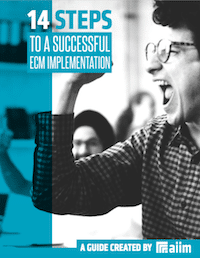The AIIM Blog
Keep your finger on the pulse of Intelligent Information Management with industry news, trends, and best practices.
Last week, I had the privilege of teaching our inaugural Foundations of Intelligent Information Management course in Denver, CO. We had students from a variety of industries and locations take part in the course, which is designed to provide participants with a thorough understanding of the fundamentals of information management. Over four days, we covered the entire lifecycle of information management: Creating and capturing information Extracting intelligence from information Digitalizing core business processes Automating governance and compliance Implementing an information management solution
Share
Enterprise Content Management (ECM) | Metadata | Taxonomy
Last weekend, we moved my daughter up to New York City. She started a job today as a nurse at Columbia Presbyterian hospital, and the apartment is on 10th Avenue a bit north of the Port Authority (pizza place on one side of the door, Irish bar on the other, Dunkin Donut down the block – what’s not for me to like?). My wife and I are alternately very proud and terrified of her accomplishment and move. Mostly the former. Her place is in the middle of the picture below by the pride flag.
Share

Making an ECM implementation successful requires planning and attention to detail. The best way to create the right solution is to identify organizational goals and priorities. Learn how to manage a successful implementation in our free guide.
Sharepoint and Office 365 | Taxonomy
Many organizations are finding that leveraging the full suite of capabilities SharePoint often requires the introduction of a new requirement – that of dealing with, managing, and exploiting taxonomies. Of course, taxonomies are not new, but there is some confusion about where managed metadata services and the term store end and true taxonomy management begins. There are also some misconceptions about the process of deriving and applying taxonomies in SharePoint. The following are five areas of confusion that we have seen in our engagements and research.
Share
Search engines have come a long way in their ability to help users find desired information among electronic content within an enterprise. Technologies vary, but no matter the search method, all kinds of searches can be enhanced if a taxonomy is also brought into play. Regardless of how content is indexed (simple crawling, concept extraction, use of algorithms, use of rule sets, etc.), taxonomies can enhance the search, by boosting accuracy in retrieval results and by improving the user experience. More specifically, a taxonomy can support search in the following eight ways.
Share
Metadata | Sharepoint and Office 365 | Taxonomy
Organizations use SharePoint for a variety of purposes, from intranets, extranets, and customer portals to document management and team collaboration. There’s been significant excitement about new product functionality introduced as part of the SharePoint 2010 platform for taxonomy implementation and management across sites and site collections. However, to get to a point where information assets are fully exploited and working to meet the needs of the organization, time and effort must be spent building an appropriate foundation for the information ecosystem – through design, development, and application of foundational information architectures and enterprise taxonomy. A well planned and intelligently constructed foundation is the basis for successful information applications and high-quality user experiences.
Share
Enterprise Content Management (ECM) | Metadata | Taxonomy
Information is our most important corporate asset, but the value of that information can only be realized if users can quickly find and use it. All too often, companies are handcuffed by numerous departmental or standalone content management systems, each with unique or incomplete information architectures. Getting to enterprise information architecture requires careful consideration during the design process, including: Requirements and not just technology should dictate the architecture.
Share